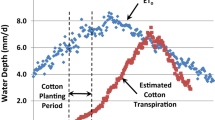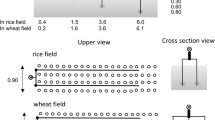Abstract
During the cultivation periods of 2001 (a dry year) and 2002 (a wet one), an experimental cotton field was irrigated using a subsurface and a surface drip system. Both systems included drip-lines 17-mm in diameter, with emitters discharging 3.8 l/h and spacing 1 m. The treatments included four irrigation levels. These were equal to 120%, 100%, 80% and 60% of the net crop water requirements during each irrigation interval. For their calculation the FAO56–Penman–Monteith methodology that estimates crop evapotranspiration was utilised. From the statistical analysis of the harvested cotton plantations it has been found that during the dry year (2001) the seed cotton yields were significantly higher where the subsurface irrigation system was used and the irrigation applications met the 80% and 60% of the crop water needs. During the two experimental years the higher irrigation applications, 120% and 100% of the crop water needs, gave seed cotton yields that did not differ significantly for both systems (subsurface and surface).
Similar content being viewed by others
References
Alam B, Trooien T, Rogers D (2000) Subsurface drip irrigation for alfalfa in western Kansas. 6th international micro-irrigation congress, South Africa
Alexiou I, Kalfountzos D, Kotsopoulos S, Vyrlas P, Kambeli S (2003) Comparison of subsurface and surface drip irrigation of cotton crop. In: Proceedings of 9th national congress of the hellenic hydrotechnical association, vol A, April 2–5. Thessaloniki, Greece, pp 199–206 (in Greek)
Allen RG, Smith M, Pruitt WO, Pereira LS (1996) Modifications to the FAO crop coefficient approach. In: Camp CR, Sadler EJ, Yoder RE (eds) Proceedings of the international conference of the ASAE on evapotranspiration and irrigation scheduling, November 3–6. San Antonio, Texas, pp 124–132
Allen RG, Pereira LS, Raes D, Smith M (1998) Crop evapotranspiration: guidelines for computing crop water requirements. FAO irrigation and drainage paper no. 56. FAO, Rome
Ayars JE, Schoneman RA, Dale F, Meso B, Shouse P (2001) Managing subsurface drip irrigation in the presence of shallow ground water. Agric Water Manag 47:243–264
Doorenbos J, Kassam AH (1979) Yield response to water. FAO irrigation and drainage paper no. 33. FAO, Rome
Doorenbos J, Pruitt WO (1977) Crop water requirements, FAO irrigation and drainage paper no. 24. FAO, Rome
Hanson B, May D (2004) Effect of subsurface drip irrigation on processing tomato yield, water table depth, soil salinity, and profitability. Agric Water Manag 68:1–17
Jensen ME, Burman RD, Allen RG (eds) (1990) Evapotranspiration and irrigation water requirements, ASCE manuals and reports on engineering practice no 70. ASCE, New York
Kotsopoulos SI, Svehlik ZJ (1989) Analysis and synthesis of seasonality and variability of daily potential evapotranspiration. Water Resour Manag 3:259–269
Kotsopoulos S, Kalfountzos D, Alexiou I, Zerva G, Karamaligas C, Vyrlas P (2002) Actual evapotranspiration and soil moisture studies in irrigated cotton fields. In: Proceedings 5th international conference of EWRA on water resources management in the era of transition, 4–8 September 2002. Athens, Greece, pp 65–73
Phene CJ, Ruskin R (1995) Potential of subsurface drip irrigation for management of nigrate in wastewater. In: Lamm FR (ed) Microirrigation for a changing world: conserving resources/preserving the environment. Proceedings of the 5th international microirrigation congress, April 2–6. Orlando, Florida, pp 155–167, American Society of Agricultural Engineers
Phene CJ, Blume MF, Hile MMS, Meek DW, Re JV (1983) Management of subsurface trickle irrigation systems. ASAE paper no. 83–2598
Phene CJ, Davis KR, McCormick RL, Heinrich D (1988) Subsurface drip irrigation: management for maximizing yields and reducing drainage. In: Proceedings of drip irrigation symposium. San Diego, California, pp 34–54
Ruskin R (2000) Subsurface drip irrigation and yields. Geoflow, Inc
Sakellariou-Makrantonaki M (1997) Water drainage in layered soils. Laboratory experiments and numerical simulation. Water Resour Manag 11:437–444
Sakellariou-Makrantonaki M, Kalfountzos D, Vyrlas P (2002) Water saving and yield increase of sugar beet with subsurface drip irrigation. Global Nest: The Int J 4(2–3):85–91
Smith M, Allen RG, Pereira LS (1996) Revised FAO methodology for crop water requirements. In: Camp CR, Sadler EJ, Yoder RE (eds) Proceedings of the international conference of the ASAE on evapotranspiration and irrigation scheduling, November 3–6. San Antonio, Texas, pp 116–123
Solomon K (1993) Subsurface drip irrigation: product selection and performance. In: Jorgensen GS, Norum KN (eds) Subsurface drip irrigation: theory, practices and application, CATI Publication no. 921001, California State University FRESNO, California, pp 3–25
Tsakiris GP (1988) Daily potential evapotranspiration modelling. Agric Water Manag 13:393–402
Author information
Authors and Affiliations
Corresponding author
Rights and permissions
About this article
Cite this article
Kalfountzos, D., Alexiou, I., Kotsopoulos, S. et al. Effect of Subsurface Drip Irrigation on Cotton Plantations. Water Resour Manage 21, 1341–1351 (2007). https://doi.org/10.1007/s11269-006-9085-4
Received:
Accepted:
Published:
Issue Date:
DOI: https://doi.org/10.1007/s11269-006-9085-4




